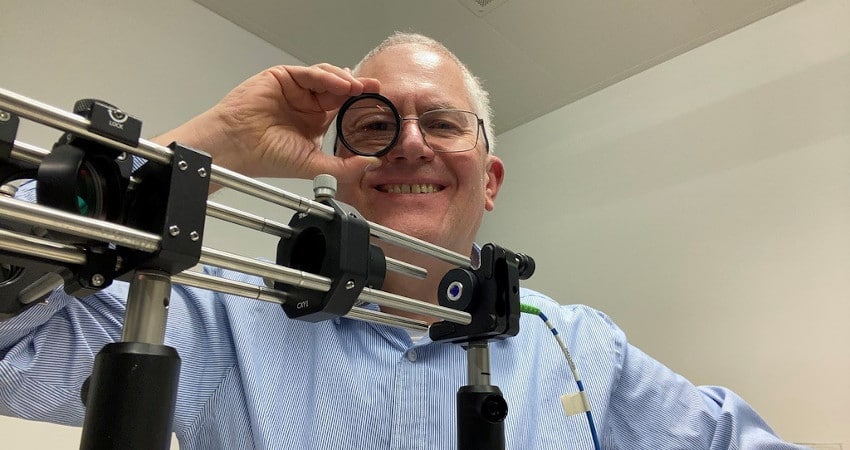Can you introduce your organization?
The Laboratory for Measurement and Sensor System Technique (MST) and the Center for Biomedical Computational Laser Systems (BIOLAS) at the Technische Universität Dresden are conducting paradigm-shifting research on innovative measurement systems in the field of optics and ultrasound. Patented innovations have been successfully transferred to the market. Breakthroughs in computational laser systems have been translated into real-world applications for energy reduction, novel multimode fiber communications techniques, and advanced lens less biomedical imaging.
In which context do you use adaptive optics and deformable mirrors?
Imaging-based measurement systems are widespread because they often feature high spatiotemporal resolution. However, the optical access can introduce dynamic aberrations. One example are flow measurements through fluctuating phase boundaries. If we want to measure the flow inside oscillating droplets that are placed on an opaque surface, the only optical access is the fluctuating droplet surface. Such measurements can be crucial for fuel cells to save energy because the removal of droplets from the opaque membrane is still an unresolved issue. Our approach is to use adaptive optics for correcting the dynamic aberrations in real-time that are introduced by the fluctuating air-water phase boundary. This way, we can conduct optical measurements through wavy water surfaces.
How long have you been working with our products?
We already work with ALPAO deformable mirrors since 2015. Hannes RADNER had a lot of contact with ALPAO’s Hardware development department. Even now, after he has founded his own company (Radner Research and Development GmbH), he still enjoys talking about the collaboration with ALPAO and sharing his good memories about it. Currently, we are working with ALPAO’s deformable mirrors towards breakthroughs in fluid mechanics and biomedicine.
Which advantages do you see in our deformable mirrors, in our technology?
For correcting the aberrations of fluctuating phase boundaries, we need adaptive optics components with a fast response time and many degrees of freedom to correct complex aberrations. Furthermore, we also profit from the good collaboration with ALPAO’s engineers. Without the detailed information about the characteristics of these mirrors, that was communicated to us, it would have been very difficult or even impossible to pursue our research. ALPAO was the only company that offered us this option. For the first time worldwide, we have realized a closed-loop deformable mirror system with Fresnel guide star in reflection mode: H. Radner, J. Stange, L. Büttner, J. Czarske, “Field programmable system-on-chip based control system for real-time distortion correction in optical imaging”, IEEE Transactions on Industrial Electronics 68(4), 2021.
Hannes Radner has won for his dissertation “Adaptive optical wavefront correction using the Fresnel guide star and a hybrid control loop implemented on a field-programmable system-on-chip” (2021), the Award of the Gisela and Erwin Sick Foundation, the Dr.-Ing. Siegfried Werth Prize for dimensional metrology, and the Barkhausen Prize of the faculty electrical and computer engineering of the Technische Universitaet Dresden, endowed by Siemens AG.
Would you recommend ALPAO to your scientific community?
Yes, sure! The products are very reliable and work well. The excellent support from ALPAO has been very helpful to our research.
Which perspectives do you see for AO in microscopy?
Because we were already quite successful with applying adaptive optics in microscopy and still have many ideas, we anticipate a perpetual performance increase in microscopy through adaptive optics.
BIOGRAPHIES
Juergen Czarske (portrait picture), fellow of Optica, SPIE, EOS, IET, is chair professor and director based at TU Dresden. He studied electrical engineering and physics and obtained his PhD degree and the Venia Legendi from Leibniz University. He has held visiting positions at NTT, MIT, Bell Labs, Stanford, Virginia Tech, NASA, and CalTech. His awards include the 1996 Measurement Technique Prize of Association of University Professors (AHMT), the 2008 International Berthold Leibinger Innovation Prize, the 2019 Optica Joseph Fraunhofer Award/Robert M. Burley Prize (Washington DC), and the 2020 Laser Instrumentation Award of IEEE Photonics Society (New York City). He is Vice President of International Commission for Optics (ICO). The ICO is the umbrella organization for optics and photonics with over 50 territorial members and 7 scientific organizations (SPIE, Optica, EOS,…). Together with his staff members and students he has formed the chair to a renowned institution for computational laser and ultrasound-based measurement systems. Over 60 scientific prizes and honors have been awarded to staff members and students of the chair.
Lars Büttner studied physics at Clausthal University of Technology, Clausthal-Zellerfeld, Germany. Since 1999, he was a Research Fellow with the Laser Zentrum Hannover, Germany. He received the Ph.D. degree in physics from Leibniz Universität Hannover in 2004. Since 2005, he has been with Technische Universität Dresden, Germany, where he is currently the Head of the Flow Measurement Group at the Laboratory for Measurement and Sensor System Techniques. His current research interests include laser- and ultrasound-based measurement techniques and adaptive optical systems. He is co-recipient of the 2008 third prize of the international Berthold Leibinger Innovationspreis.
Clemens Bilsing received a Diploma degree in electrical engineering from the TU Dresden in 2020. Since 2021, he is part of the research group led by Dr. Lars Büttner. His current research interests include the application of adaptive optics for flow measurements through fluctuating phase boundaries. He received the DGaO (The German Branch of European Optical Society) Young Talent Award 2020 for his diploma thesis “Novel laser measurement system with adaptive image correction using helical wavefronts and a deformable mirror”.


